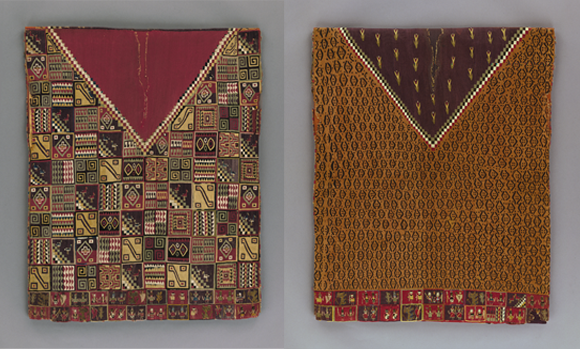The Andean Uncu
The men's tunic (uncu) was highly standardized in format, dimensions, and construction during the period of Inca sovereignty. Uncus were made of interlocked tapestry with cotton and the wool-like yarn derived from camelids (llama, alpaca, guanaco, and vicuña). The finest cloth (cumbi) was woven by specialists and reserved for the ruler and for rituals.
Tunics from various provinces of the Inca Empire were woven in patterns of local origin, such as the eight-pointed "star" characteristic of the far south of Peru. The most common format was a solid or patterned grid. Texts and images by Spanish chroniclers describe Inca soldiers dressed in tunics resembling a checkerboard, symbolic of the Inca administration.
The double-side tunic illustrated here is a composite of Inca and European structure and symbolism. In format the V-shaped, stepped yoke is Inca, and the tunic is finely woven in the standard Inca tapestry technique. It is decorated with tocapu—the square geometric patterns associated with elite lineage, rank, or profession. Distinctive European modifications are the contrast between the front and back designs, which in Inca times were identical, and the incorporation of silver metallic thread, not used in Andean textiles before the arrival of the Spanish.
Exhibition Home Page Andean Drinking Vessels
Image: Man's Tunic (Uncu) with Tocapu and Stylized Jaguar Pelt Design, (double-sided), Bolivia, Lake Titicaca, mid- to late 16th century; tapestry weave; cotton warp; camelid, silk, and metallic weft; 38 x 30 in. (97.8 x 78.1 cm); American Museum of Natural History, Division of Anthropology, New York, B/1500. Photo © American Museum of Natural History Library, New York (B/1500).